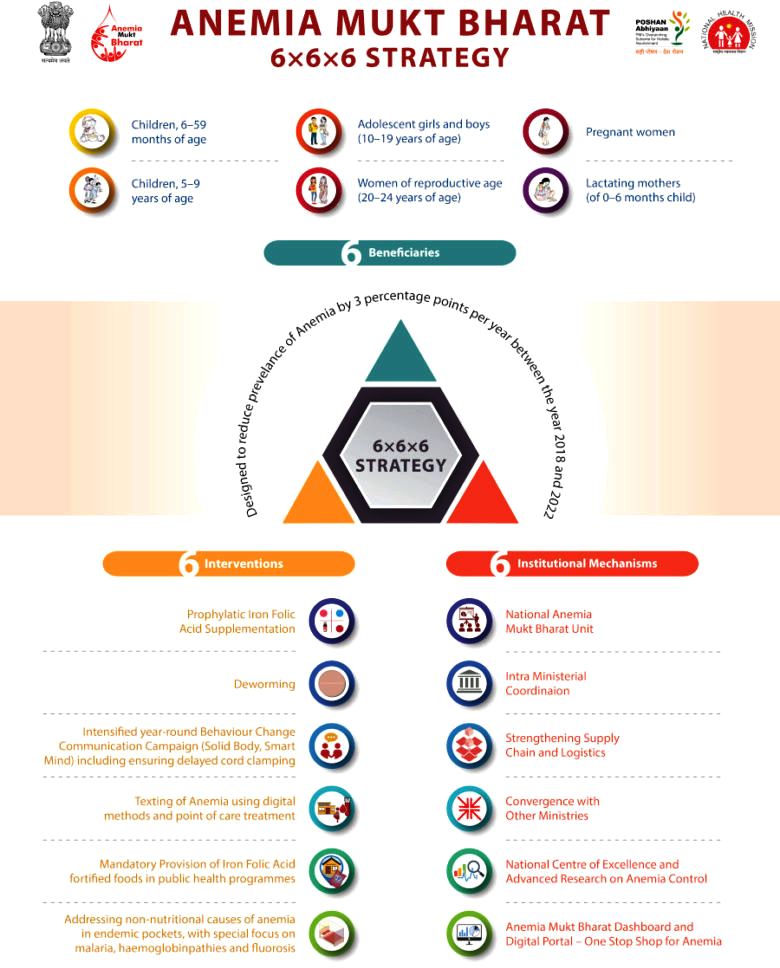Anaemia Mukt Bharat | 07 Feb 2022
For Prelims: Anaemia Mukt Bharat , 6X6X6 strategy, National Family Health Survey 2019-20, Pradhan Mantri Surakshit Matritva Abhiyan.
For Mains: Women and child welfare, Health initiatives.
Why in the News?
Recently, the Union Minister of State for Health and Family Welfare provided information on Anaemia Mukt Bharat (AMB) strategy.
- In 2018, the Government of India launched the AMB strategy with the target to reduce anaemia in the vulnerable age groups such as women, children and adolescents.
- AMB is based on a life cycle approach, providing preventive and curative mechanisms through a 6X6X6 strategy including six target beneficiaries, six interventions and six institutional mechanisms for all stakeholders to implement the strategy.
What is Anaemia?
- It is a condition in which the number of red blood cells or their oxygen-carrying capacity is insufficient to meet physiologic needs, which vary by age, sex, altitude, smoking, and pregnancy status.
- Iron deficiency is the most common cause of anaemia, although other conditions, such as folate, vitamin B12 and vitamin A deficiencies, chronic inflammation, parasitic infections, and inherited disorders can all cause anaemia.
- In its severe form, it is associated with fatigue, weakness, dizziness and drowsiness. Pregnant women and children are particularly vulnerable.
- According to the National Family Health Survey 2019-20, Indian women and children are overwhelmingly anaemic.
- Under phase I, 22 states and UTs were surveyed and in a majority of these states and UTs, more than half the children and women were found to be anaemic.
- According to the World Health Organization (WHO), women in the reproductive age group and having haemoglobin levels lower than 12 grams per decilitre (g / dL), as well as children under five with haemoglobin levels lower than 11.0 g / dL are considered anaemic.
What are the Highlights of AMB Strategy?
What are Other Government Initiatives for Controlling Anaemia?
- Health is a State subject and the primary responsibility for strengthening health care services including implementation of national programs lies with the respective State/UT government.
- The Ministry of Health and Family Welfare provides financial and technical support to States/UTs under the National Health Mission.
- Weekly Iron and Folic Acid Supplementation (WIFS): This Programme is being implemented to meet the challenge of high prevalence and incidence of anaemia amongst adolescent girls and boys.
- The intervention under WIFS includes supervised weekly ingestion of Iron Folic Acid (IFA) tablets.
- To control worm infestation, biannual deworming with Albendazole is provided.
- Health Management Information System & Mother Child Tracking System: It is being implemented for reporting and tracking the cases of anaemic and severely anaemic pregnant women.
- Universal Screening of Pregnant Women for Anaemia: It is a part of Ante-Natal Care (ANC) and all pregnant women are provided iron and folic acid tablets during their ante-natal visits through the existing network of sub-centres and primary health centres and other health facilities as well as through outreach activities at Village Health & Nutrition Days (VHNDs).
- Pradhan Mantri Surakshit Matritva Abhiyan (PMSMA): It has been launched to focus on conducting special ANC check up on 9th of every month with the help of Medical officers to detect and treat cases of anaemia.
- Operationalization of Blood Bank in District Hospitals and Blood Storage Unit in sub district facilities such as Sub-Divisional Hospital/ Community Health Centers is being taken to tackle complications due to severe anaemia.

